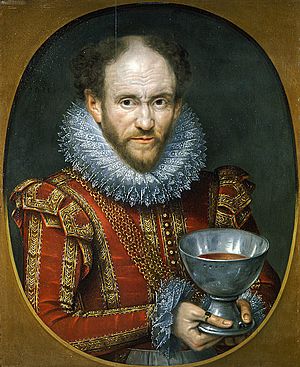Tom Durie facts for kids
Tom Durie, also known as Duri, Dury, or Derry, was a Scottish entertainer and jester who lived around the early 1600s. He worked for Anne of Denmark, who was the Queen of Scotland and England. Jesters were like comedians and performers who entertained kings and queens with jokes, stories, and sometimes even music.
Contents
Tom Durie's Life as a Jester
Tom Durie first appears in records in May 1603. He was given new clothes to travel with Anne of Denmark to England. This trip happened after Scotland and England joined under one king, King James. His new clothes included a "green coat" for "Thomas Durie her Majesty's fool."
Early Days and Disappearance
In October 1604, the Queen's secretary, William Fowler, wrote a letter mentioning that "Thom. Ducie [sic] is missing." It's thought he was talking about Tom Durie. If so, he later returned to court, but the details aren't clear.
King James's Jokes
In 1607, King James found a letter from Sir Robert Cecil very funny. The letter was about a courtier getting a new job in Queen Anne's household. King James asked the Earl of Dunbar to reply. He wrote that Cecil was "so good a fool" and only needed to worry about "Thom. Durey" getting jealous. This shows that Tom Durie was well-known and even joked about by the King.
Famous Portraits
Queen Anne had Tom Durie's picture painted in 1614 by Marcus Gheeraerts the Younger. Another artist, Paul van Somer, also painted him. Gheeraerts's painting is now shown at the National Gallery of Scotland.
His portrait was displayed in important places. At Somerset House in London, it was in a room between the Queen's private area and the gallery. In 1619, it was listed as the picture of "Thomas Derry." Later, during the time of King Charles I, this area was even called "Tom Derry's gallery."
Queen Anne also had his portrait at Oatlands Palace. Another painting of him was later seen in the Queen's Gallery at Greenwich Palace. It was displayed there with pictures of Anne's family from Denmark.
Mystery of the Silver Cup
In one of his portraits, Tom Durie is shown with a large silver cup. The meaning of this cup is not fully known. However, William Fowler, the Queen's secretary, wrote a note about "Tho Duryes portrait." This note included a Latin phrase: "Odi memorem comptorem." This means "I hate a drinking companion with a good memory." This might give us a clue about the cup or Tom Durie's personality.
Clothes and Expenses
When Prince Henry died in 1612, Tom Durie was given special mourning clothes. Another jester at court, Archibald Armstrong, wore a fancy red velvet coat with gold lace at a royal wedding in 1613. Tom Durie's portrait shows him in similar colorful clothes.
In 1612, Tom Durie's weekly food and lodging cost 7 shillings. He even had a helper named John Mawe. By 1618, both Tom Durie and his keeper, John Mawre, had horses. In 1619, a "grey horse" was bought for Tom Durie for £12. By this time, he was known as the King's fool.
Tom Durie was still around in 1620, as records show he was paid for his food and lodging. Some receipts for his and Archy Armstrong's costumes are kept in historical papers.
The Dunfermline Story
In 1623, a man named Thomas Rant shared a story about Queen Anne and a jester, likely Tom Durie. This happened at Dunfermline Palace in 1600. The Queen, who was pregnant with Prince Charles, wanted to hear a special church service called the Mass at night. Her jester watched the service. He then described it to King James as a "midnight feast." King James was curious but seemed satisfied when he heard it was a religious service.
How Tom Durie Was Seen by Others
People at court often talked about Tom Durie. King James himself sometimes called Robert Cecil "young Tom Durie." This was a playful nickname.
Comparisons and Jokes
Robert Cecil once apologized for being rude, saying that if he had done it on purpose, he would be "worse than Tom Dyrry." This suggests that Tom Durie might not have always followed strict court rules. In another funny letter, Cecil joked that if someone couldn't get a job in Prince Henry's household, they should be sent to "Tom Dyrry or to me." Robert Cecil was short, and people at court often made jokes about his height.
In 1607, there was a lot of competition for a job in the Queen's household. George Home told Robert Cecil a joke from the King. The King said that "Thom. Durey" might be jealous that a noble and his son were trying to get his job. This shows how well-known Tom Durie was.
Pay and Status
After Queen Anne died, one of her long-time servants, William Belo, complained that he hadn't been paid enough. He said he was paid less than Tom Durie, who he called a "natural fool," and Archie Armstrong, who he called a "fake" jester. This shows that jesters like Tom Durie were sometimes paid quite well for their entertainment.


